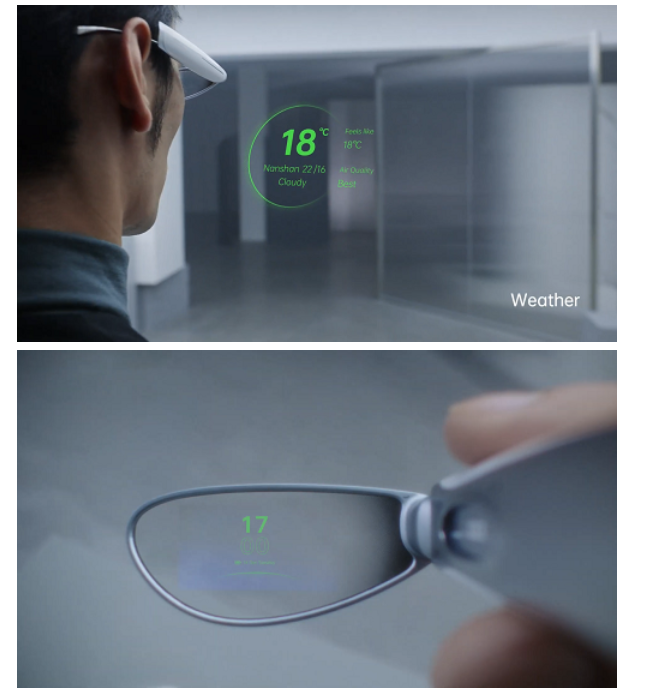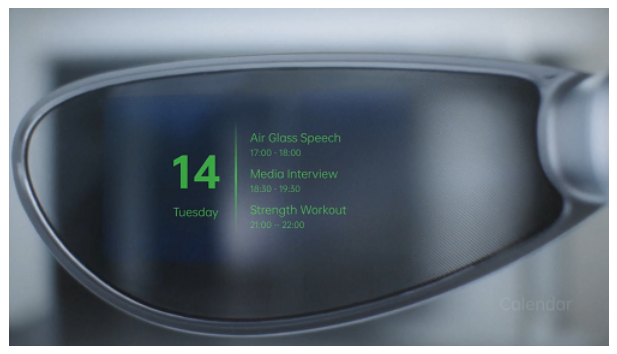On December 14, OPPO held the OPPO Inno Day 2021 event in Shenzhen, China and announced its next-gen smart glasses, the Air Glass (hereinafter “OPPO Air Glass”).
As the third smart glass product of OPPO, OPPO Air Glass signifies the transition from being simply a toy to a tool thanks to its excellent design and useful features.
OPPO Air Glass Is Powered by “Assisted Reality” Rather than “Augmented Reality”
OPPO Air Glass is arguably an “atypical” AR glass product; to be specific, it is more like an assisted reality (rather than “augmented reality”, the term that we normally associate with AR) product.

It turns out that assisted reality is a result of evaluation and decision-making based on the existing technological limits. During the event, Jiang Bo, OPPO’s senior director of chip products, and Xu Yi, director of XR technology, told the media that augmented reality products have yet to mature and that several problems must be solved for market entry. Because the commercialization of augmented reality products will still take some time to occur, announcing an “assisted reality” product makes perfect sense.
Unlike the genuine AR glasses, OPPO Air Glass does not perform 3D modeling on real objects and cannot play AR videos. Its purpose is simple: projecting information including reminders, navigation information, translations and teleprompter cues onto the lenses.
The information provided is extremely useful. OPPO Air Glass, for example, can display navigation maps with translations for users when travelling abroad. Before users leave their home, the glasses presents weather forecasts and the schedule of the day. During a speech or conference, the assisted reality product can project important information onto its lenses, which is a big help for the speaker.

Specifically, OPPO signed a strategic alliance agreement with Baidu Maps, allowing the Air Glass to provide walking and driving directions using graphic and voice reminders and explore surrounding areas on the map.
OPPO Air Glass is no doubt a handy tool in everyday life. For the convenience of users, OPPO equips four interactive control modes with the glass product, namely touching, voice, gesture and head-motion control. Users can then freely switch between these modes as they wish.
From Toy to Tool, Interior Changes in OPPO Air Glass
Liu Chang, OPPO’s dean of research institute, said in the OPPO Inno Day 2021 event, “In the future, smart glasses will be the third crucial ‘screen’ in our life following smartphones and watches. We are glad to announce OPPO Air Glass, a pair of smart glasses that consumers can really get a hold of.”
Compared with its previous two counterparts, OPPO Air Glass represents a great breakthrough as a consumer electronic product.
Light weight is its first strength. Being small, light and portable is a key feature driving consumers to buy a wearable. The monocular spectacles come with an additional frame and weigh only 30g with ultra-thin 1.3mm lenses, making the gadget “as light as a feather, as thin as a cicada wing”.
Concerning display, OPPO Air Glass adopts the diffractive optical waveguide solution with a Micro LED screen, which can deliver up to 3 million nits of brightness and 1400 nits on average. The product also comes with OPPO’s self-developed Spark—a coffee bean-sized micro projector that is currently the smallest in the industry. The said configurations have contributed to the light weight and excellent display performance of the glasses.

As for its appearance, the Air Glass comprises a separate package housing display, projector and computing modules, which is magnetically attached to the frame from which it can be separated. OPPO also offers two frame options for people with normal vision and those who need vision correction.

Notably, despite being the third generation of OPPO’s AR glasses, the Air Glass is the first model scheduled for mass production in spring next year.
As AR Glasses Market Is Taking Off, Micro LED Becomes Promising
AR glasses have seen actual and predictable demand in the consumer market, as they are likely to be the next big end product. As research company TrendForce estimates, shipments of VR/AR devices will hit 12.02 million in 2022 with an annual growth rate of 26.4%.
As a near-eye display device, AR glasses have strict requirements of display resolution. Moreover, they must have high brightness for various application scenarios. Although its cost will remain high for years to come, Micro LED can potentially outperform LCD and OLED in resolution and brightness. Therefore, Micro LED has become a favorable display technology for AR/VR/MR devices.
On September 14, Xiaomi released an exploration version of smart glasses. The spectacles are engineered with Micro LED display and waveguide technologies; this end product that emulates human vision can thus provide smart experiences for its users.
Thunderbird, an AR startup funded by TCL, unveiled its pioneer-edition smart glasses on October 15. It is the first AR glasses in the industry that features Micro LED, holographic imagery and a waveguide.
Furthermore, Japanese startup Cellid announced on November 10 that samples of its display module for AR glasses have become available. The module, Cellid Waveguide 60, is equipped with a Micro LED projector with the world’s widest 60-degree FoV in waveguide architecture.
Indeed, the cost problem of AR glasses engineered with Micro LED must be solved before they gain a favorable market share. Nevertheless, we believe that as time goes by, AR glasses will become an essential application for Micro LED (summarized by Lynn from LEDinside).












